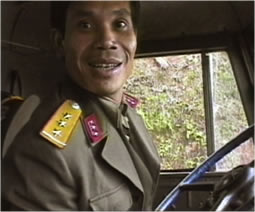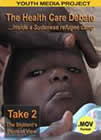You're receiving this newsletter because you signed up on our website at take2videos.org.
You may

The Kindness of Strangers
I was 28 when I put on a backpack and left for Vietnam. The country still had an evil reputation in the USA, and I naively thought that if a woman could hitchhike alone there for a year, then people would have to rethink some of their negative perceptions.
Early one morning I found myself on a dirt road just outside of Hanoi, waiting for my first ride. Suddenly I wasn’t quite as confident as I had been in front of my family and friends. The voice of a Vietnam vet I’d met in Boston kept ringing in my ears.  “You’ll be raped and mugged and murdered. Snakes and Commies in the grass.”
“You’ll be raped and mugged and murdered. Snakes and Commies in the grass.”
An enormous military truck suddenly appeared and pulled over to pick me up. I climbed in next to the driver. He was a north Vietnamese lieutenant, impeccably dressed in an olive-green uniform. “Where you from?” he asked. “America,” I mumbled out of one corner of my mouth. “America!” he said in shock, then grinned from ear to ear. He made a thumbs-up sign with both hands and used up the last of his English. “America number one! Welcome back!”
We drove together for sixteen hours before pulling up beside a truckers’ flophouse in a remote village. He looked at me. “Where are you going to sleep?” he asked.
The Value of a Human Life
Because our footage focuses on issues like education and displacement, our materials are most popular with social studies and English teachers. I was therefore quite surprised when a math department chair signed on with us. I was even more impressed when I found out how he was using the footage.
Every day he came into class and wrote a single question on the board:
![]()
“What is the value of a human life?”
He asked his students to create documentaries about humanitarian aid in the refugee camps – while figuring out how to answer the question. He didn’t offer them any statistics or tell them where to look things up. Some of the students tried to determine the value of the items provided to the refugees each month.
Then one student stumbled across the Ford Pinto scandal from the 1970s, where a faulty gas tank design resulted in burn deaths and a lawsuit against the manufacturer. The student used the court judgment to determine the value of a human life. This led to an investigation of insurance companies and how insurance rates are based on their valuation of human life, which resulted in some passionate debates on whether an older woman is “worth” less than a teenage girl or a homeless man than a doctor. At his students’ request, the teacher taught them statistics and other mathematical skills they needed to get the answers they were looking for. In the last week of class they had their answer –a human life is worth somewhere between seven dollars a month and five million dollars over the course of a lifetime - depending on whose life it was. That led to a discussion on ethics and another one on why students should not blindly accept any statistics they find without investigating the methodology. 
The final exam was a paper in which the students had to answer an entirely new question – “How many gas stations are there in the United States?” They wrote out their assumptions, used their intuition, and worked their way logically to a conclusion. Just as they had learned in class.
Einstein once said that the formulation of a problem is often more essential than its solution. Those students learned to think mathematically, formulate problems, and ask the right questions. They also learned that math can be exciting, it can be fun, and that it can make sense of the world.
To learn more about Take 2, please visit us at:
www.take2videos.org
"Listening to these students speak so intelligently, eloquently, and
passionately
about this topic was absolutely amazing for me; I really
can’t even express
how blown away I was about the whole weekend."
Teacher, Quebec
 throughout North America have the opportunity to edit National Geographic-quality raw footage to create their own documentaries and shorts. Take 2 is offering in-depth, professional footage that comes with a comprehensive curriculum and teaching tools that meet the state and national curricular standards for social studies, economics, government, science, media, or literature. Teachers do not need to have any video or editing skills – teaching tools are available in the supporting materials.
throughout North America have the opportunity to edit National Geographic-quality raw footage to create their own documentaries and shorts. Take 2 is offering in-depth, professional footage that comes with a comprehensive curriculum and teaching tools that meet the state and national curricular standards for social studies, economics, government, science, media, or literature. Teachers do not need to have any video or editing skills – teaching tools are available in the supporting materials.